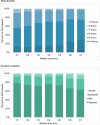Association of sleep quality with duty hours, mental health, and medical errors among Japanese postgraduate residents: a cross-sectional study
- PMID: 38233476
- PMCID: PMC10794685
- DOI: 10.1038/s41598-024-51353-8
Association of sleep quality with duty hours, mental health, and medical errors among Japanese postgraduate residents: a cross-sectional study
Abstract
Long duty hours (DH) impair sleep and negatively affect residents' health and medical safety. This cross-sectional study investigated the association among residents' DH, sleep duration, insomnia, sleep impairment, depressive symptoms, and self-reported medical errors among 5579 residents in Japan who completed the General Medicine In-Training Examination (2021) and participated in the training-environment survey. Weekly DH was classified under seven categories. Sleep duration and insomnia symptoms, from the Athens Insomnia Scale, were analysed to determine sleep impairment; depressive symptoms and medical errors were self-reported. Among 5095 residents, 15.5% slept < 5 h/day, and 26.7% had insomnia. In multivariable analysis, compared with ≥ 60 and < 70, DH ≥ 90 h/week associated with shorter sleep duration and worsen insomnia symptoms. Shorter durations of sleep and more intense symptoms of insomnia were associated with increased depressive symptoms. Medical errors increased only among residents with insomnia, but were not associated with sleep duration. DH > 90 h/week could lead to shorter sleep duration, worsen insomnia symptoms, and negatively impact well-being and medical safety. There was no significant association between sleep duration and medical errors; however, insomnia conferred an increased risk of medical errors. Limiting DH for residents to avoid excessive workload can help improve resident sleep, enhance resident well-being, and potentially reduce insomnia-associated medical errors.
© 2024. The Author(s).
Conflict of interest statement
Dr. Nishizaki received an honorarium from JAMEP as the GM-ITE project manager. Dr. Tokuda is the JAMEP director. Dr. Kobayashi and Dr. Shikino received an honorarium from JAMEP as speakers for the JAMEP lecture. Dr. Shimizu, Dr. Yamamoto, Dr. Shikino, and Dr. Fukui received an honorarium from JAMEP as exam preparers for GM-ITE. Dr. Nishizaki, Dr. Tokuda, Dr. Kobayashi, Dr. Shimizu, Dr. Yamamoto, Dr. Shikino, and Dr. Fukui were not involved in this analysis. Dr. Nagasaki, Dr. Kurihara, Dr. Watari, Dr. Nishiguchi, and Dr. Katayama have no conflicts of interest to declare.
Figures


Similar articles
-
Association between prolonged weekly duty hours and self-study time among residents: a cross-sectional study.Postgrad Med J. 2023 Sep 21;99(1176):1080-1087. doi: 10.1093/postmj/qgad044. Postgrad Med J. 2023. PMID: 37265446
-
The impact of duty hours on resident self reports of errors.J Gen Intern Med. 2007 Feb;22(2):205-9. doi: 10.1007/s11606-006-0065-4. J Gen Intern Med. 2007. PMID: 17356987 Free PMC article.
-
Effects of the accreditation council for graduate medical education duty hour limits on sleep, work hours, and safety.Pediatrics. 2008 Aug;122(2):250-8. doi: 10.1542/peds.2007-2306. Pediatrics. 2008. PMID: 18676540
-
Resident duty hours in Canada: a survey and national statement.BMC Med Educ. 2014;14 Suppl 1(Suppl 1):S9. doi: 10.1186/1472-6920-14-S1-S9. Epub 2014 Dec 11. BMC Med Educ. 2014. PMID: 25559388 Free PMC article. Review.
-
The Interventional Arm of the Flexibility In Duty-Hour Requirements for Surgical Trainees Trial: First-Year Data Show Superior Quality In-Training Initiative Outcomes.J Surg Educ. 2016 Nov-Dec;73(6):e131-e135. doi: 10.1016/j.jsurg.2016.07.015. Epub 2016 Sep 16. J Surg Educ. 2016. PMID: 27651054 Review.
Cited by
-
Five Strategies for Efficient and Effective Training of Japanese Resident Physicians Under the Japanese Work Style Reform.Adv Med Educ Pract. 2025 Apr 5;16:577-581. doi: 10.2147/AMEP.S511015. eCollection 2025. Adv Med Educ Pract. 2025. PMID: 40212343 Free PMC article.
-
Validation of the Athens Insomnia Scale Among Young Chinese Male Population in a High-Altitude Situation.Nat Sci Sleep. 2024 Sep 17;16:1377-1386. doi: 10.2147/NSS.S475497. eCollection 2024. Nat Sci Sleep. 2024. PMID: 39308666 Free PMC article.
-
Sleep quality and related factors among healthcare workers in designated quarantine hospital site in post-pandemic based on the health ecological model: a cross-sectional study in Nanjing, China.Front Public Health. 2024 Jul 4;12:1419665. doi: 10.3389/fpubh.2024.1419665. eCollection 2024. Front Public Health. 2024. PMID: 39026590 Free PMC article.
-
Prevalence and Correlates of Mental Health Problems in Resident Physicians in Inner Mongolia Autonomous Region: A Cross-Sectional Study.Risk Manag Healthc Policy. 2025 Apr 18;18:1377-1385. doi: 10.2147/RMHP.S494326. eCollection 2025. Risk Manag Healthc Policy. 2025. PMID: 40270805 Free PMC article.
-
Prevalence and determinants of occupational depression, anxiety, and stress among Ethiopian healthcare workers.Sci Rep. 2024 Sep 18;14(1):21817. doi: 10.1038/s41598-024-72930-x. Sci Rep. 2024. PMID: 39294429 Free PMC article.
References
-
- Ministry of Health, Labour and Welfare. Addressing the reform of the working style of physicians in the clinical training system; (2023, accessed 2 Ma 2023). https://www.mhlw.go.jp/content/10803000/000590866.pdf (in Japanese).
MeSH terms
LinkOut - more resources
Full Text Sources
Medical

